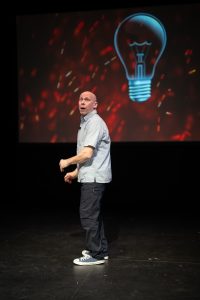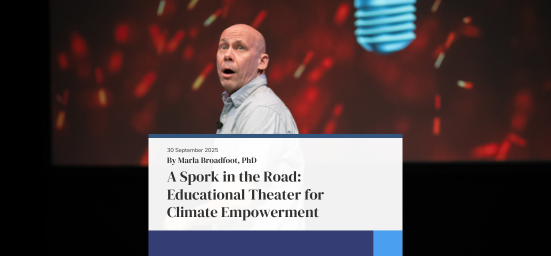Images of climate change confront children on practically every screen they encounter. A polar bear stranded on a chunk of ice. Raging wildfires. Heatwaves, hurricanes, and floods. But a different type of imagery provides the backdrop for a new piece of educational theater designed to evoke wonder in the natural world and remind the next generation why it is worth saving.
remind the next generation why it is worth saving.
The production, called A Spork in the Road, is the brainchild of David Gonzalez, a storyteller, playwright, and performer, and recipient of the Lifetime Achievement Award from International Performing Arts for Youth, and Karen Jenson, a writer, designer, and performer. Together, Gonzalez, Jenson, and their collaborators developed the project with the support of a Climate Change and Human Health seed grant from the Burroughs Wellcome Fund.
Some might ask why, with only a few years left to limit climate change catastrophe, should time and resources be devoted to making art? Gonzalez believes that question is valid.
“Artists are called to support change through whatever “media necessary” be it paint, sound, gesture, language, or theater,” he said. “A Spork in the Road promises to stand on the ground of hard science and to translate some of the most important messages of climate science to children through a vital and creative stirring of the imagination.”
Translating science into art
For two years, the team explored climate change and environmental issues through readings, interviews, videos, and conversations with an advisory board comprising climate scientists, activists, and writers, as well as time spent in nature. They drew heavily from the works of Pulitzer Prize-winning science writer and author Ed Yong, specifically his books “I Contain Multitudes” and “An Immense World.”
The project was originally conceived as a multi-actor play but evolved into a one-man show after Dean Holt, a company member at the prestigious Children’s Theater Company in Minneapolis, joined the team. That team included Holt, Gonzalez, Jensen, a lighting designer, a video designer, a sound designer, a composer, a stagehand, and a videographer. They held workshops in Holt’s hometown, developing the show through a collaborative and iterative process. Their mission was to create something that would give children information, inspire wonder, and encourage agency.
“All forms of art have that capacity,” said Fae Dremock, an activist, writer, and former faculty member in the department of environmental science and studies at Ithaca College, who advised on the project. “If you show a story, if you show something that arouses you, that makes you care about it. Whether it’s Bambi or a cat that falls off a table, you begin to open up a little bit to the ideas that might be there, and you begin to listen a bit more. And this kind of work makes you willing to listen. A Spork in the Road is very funny. It’s also very effective in a lot of ways.”
The largely non-verbal performance relied on various visual storytelling techniques. The protagonist, Spork, sounded, mimed, and danced in front of a large screen, reacting and interacting with colorful images projected onto the background, including a tree, microbes, and a light bulb. An off-stage voice occasionally dropped in to provide commentary.
“A Spork in the Road invites children to view the world around them in a new and personal way, presenting educational information about climate change and pollution, and health in the most entertaining ways,” said Stephen DiMenna, artistic director of Park Square Theater in Minneapolis, which partnered on the project.
The power of performance
On April 16, 2024, Park Square Theater hosted two live performances of A Spork in the Road for an audience of 200 schoolchildren and their teachers. Gonzalez and Jenson recalled there being instances of laughter, times when you could hear a pin drop, and moments of palpable awe. “When our protagonist, Spork, released his captured firefly back into nature and the auditorium filled with images of a forest at night, complete with a lime green disco ball and gorgeous music, the audience burst into applause. We were thrilled,” he said.
Victor Zupanc, the resident music director at the Children’s Theatre Company in Minneapolis, saw the performance, which he described as a delight and a surprise. “The audience was thoroughly engaged; they shouted questions, they cheered the performer (who was brilliant even though he did not speak a word!), they followed every storyline, and they were enraptured,” said Zupanc. “This is the type of show that is absolutely needed today.”
The team is now adapting the play to take it to on a school tour in Fall 2025. They plan to market the show to low-income school districts that typically lack opportunities to experience this type of performance, as well as science magnet schools and national performing arts centers. They are also planning to engage the communities they visit in conversation with a lively question-and-answer session after every show. Based on Gonzalez’s previous theatrical works, they estimate that more than 100,000 children will see A Spork in the Road over the five-year life of the play.
But the true measure of the play’s success may not be easy to quantify. Dremock believes that public will is necessary to drive investments in concrete approaches to combat climate change, such as innovations in clean energy. Performance art, like A Spork in the Road, may be one way to get the public to pay attention.
“But does that change minds and influence hearts and souls? I don’t know,” said Dremock. “Anything we can throw at the wall, we need to throw at the wall to get people to think about this. So in that sense, just getting it out there and making people see it and enjoy it is what makes it effective.”


Comments are closed.